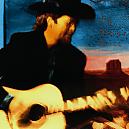In the last ten years—give or take a couple—Mark
Heard released a decade’s worth of brilliant
albums. Although generally well-received by radio,
and always meeting with critical acclaim,
Heard’s records did not set the sales charts
on fire. That, and his penchant for writing lyrics a
bit more obtuse than major Christian labels would
prefer, perhaps explains why Mark’s latest
effort is on his own Fingerprint label. Although you
may have to work a bit harder to obtain a copy, the
search for Dry Bones Dance is well worth the
effort. It’s one of the first great records of
the
’90s, and the equal of Heard’s best
’80s work, Victims of the Age.
Depending of how great your interest in alternative
music, you would either have last spotted Mark on
his own iDEoLA project, or caught a glimpse of him
backing Sam Phillips on an acoustic club tour.
Heard’s return to the studio is the
antithesis of the iDEoLA disc; where it was a “one-
man-band,” dance-oriented session of synthetic
and sampled textures, Dry Bones Dance is
entirely organic. Many of the basic tracks were
performed “live” in the studio, and the most exotic
thing you’ll hear is Heard’s kalimba
(African percussion instrument plucked with
fingers). The overall sound is acoustic-based,
country-rock. Sometimes the songs veer in a Tex-
Mex or Cajun direction, especially when Byron
Berline starts sawing his fiddle and Heard joins in
on an antique accordion. On other tracks, Heard
harkens back to Rubber Soul-era Beatles,
with delightful, chiming guitars, rich harmonies,
and riffs that are instantly hummable. Heard has
crafted 14 tracks which clock in at a generous
56:30—and not a moment is wasted!
But Mark Heard’s superb songwriting is
really at the core of Dry Bones Dance.
Heard’s lyrics have often been described as
literate, poetic, brutally honest and poignant. To
that, I would add concise. There is no fat on these
Dry Bones. Indeed, Heard may be contemporary
Christian music’s best storyteller. With just
five words—”penniless at the wishing well”—Heard
conveys a feeling of utter brokenness. In “Our
Restless Hearts,” Heard spits out the lyrics “you
smear the blame on me like cheap cosmetics” and
goes on to admonish, “if there is love, then give me
an example.” Heard turns in a great flat-picked,
bluegrass lead guitar on the loping
“Nobody’s Looking,” and sings (in his slyest
Dylan-ese) “You can pray if you want to / Go ahead,
nobody’s looking but God.” “Everything is
Alright” stresses the need for closeness with
one’s mate, while “Lonely Road” reminds
us that, no matter how tough we think
we’ve got it, the Son of Man had it
harder.
Dry Bones Dance has its harder
moments as well. The rollicking “Waiting For A
Reason,” features a wonderful 12-string hook, and
the closing, apocalyptic “Fire” combines all the
instruments and voices in a glorious
rock’n’roll stew. Heard is aided and
abetted by several excellent musicians, most
notably Fergus Marsh (of Bruce Cockburn’s
band) on stick, Byron Berline on fiddle and
mandolin, David Birmingham on drums, and Jerry
Chamberlain, Sharon McCall, Pam Dwinell, and Sam
Phillips on vocals. Perhaps at another time, we can
debate why an artist of his
caliber is forced to release recordings on his own
custom label. For now, go out of your way to obtain
Dry Bones Dance. (Sorry vinyl recluses, but
it’s only available on cassette and compact
disc).
Bruce Brown ( CCM, June 1990 )
Copyright © 1990 CCM Magazine
Mark Heard has been around for years. Of course he
originally came out of Larry Norman’s camp along
with Randy Stonehill and Tom Howard, and three
or so years back made an unsuccessful pitch for
crossover success with the synth-rock persona
Ideola. Now he’s wisely returned to his roots and
his latest is written, produced and engineered by
himself, has fourteen songs and features accordion,
fiddle, acoustic guitars and harmonica. Yep, truly
more than a folk rock album. But don’t stop
reading, it’s country that kicks gritty yet grooves,
and no-one shouts out ‘yee-ha’ anywhere on the
whole set. With touches of Leon Russell, Tom Petty
and Dylan, Mark snarls his messages of woe and
hope reaching deep within himself and pulling out
nasal howls that erupt like a coyote on the night of
a full moon. Acoustic guitar spits out riffs, the fiddle
darts in and out and the occasional telecaster keeps
us on the trail in true Jimmy Reed style. A lone
female sings the harmony, drums and bass hold the
arid atmosphere together. The texture of the music
fits the themes of the songs perfectly. The cover
pictures Mark with cowboy hat playing guitar in the
open space of the prairie. The first song “Rise From
The Ruins” speaks of the resurrection of humankind
capturing the feel of dust to dust. The title song
“Dry Bones Dance” continues the theme.
Moody...raw...well worth parting with your
£6.49
Paul Poulton ( Cross Rhythms, Nov/Dec 1990
)
Copyright © 1990 Cross Rhythms
Magazine
Coming three years after the interesting (if
unsuccessful) iDEoLA experiment, Mark Heard
returns with a rich, rootsy album full of intelligent
lyrics and well-layered music. Styles range from folk
to Appalachian to zydeco. And all of these diverse
styles are augmented by the Chapman stick of
Fergus Jemison Marsh, more widely known for his
work with Bruce Cockburn. The sounds of the more
traditional instruments really color this record
well—the accordion, the mandolin, the violin, the
hammered dulcimer—rich instrumental painting
and texture. The album has an energetic opening
with “Rise From the Ruins” and the title track, and
there’s lots of clever wordplay on “Our Restless
Hearts.” The high point on this record is one of
Heard’s prettiest songs, “Strong Hand of Love.” The
trilogy of this album, Second Hand, and
Satellite Sky comprise Heard’s strongest
work.
Mark W.B. Allender ( AMG )
www.allmusic.com
Dry Bones Dance ~
Lyrics
/
Credits
/ CCM
Interview
/
DISCOGRAPHY
